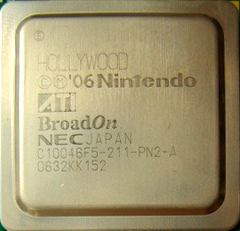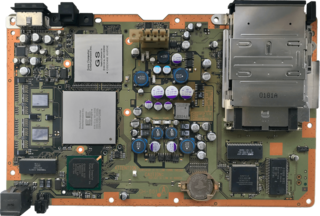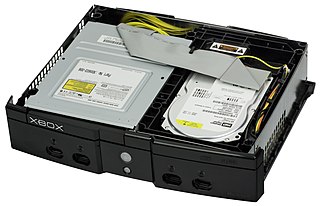
The GeForce 3 series (NV20) is the third generation of Nvidia's GeForce graphics processing units (GPUs). Introduced in February 2001, it advanced the GeForce architecture by adding programmable pixel and vertex shaders, multisample anti-aliasing and improved the overall efficiency of the rendering process.

The GeForce 6 series is Nvidia's sixth generation of GeForce graphic processing units. Launched on April 14, 2004, the GeForce 6 family introduced PureVideo post-processing for video, SLI technology, and Shader Model 3.0 support.
The R420 GPU, developed by ATI Technologies, was the company's basis for its 3rd-generation DirectX 9.0/OpenGL 2.0-capable graphics cards. Used first on the Radeon X800, the R420 was produced on a 0.13 micrometer low-K photolithography process and used GDDR-3 memory. The chip was designed for AGP graphics cards.
The R520 is a graphics processing unit (GPU) developed by ATI Technologies and produced by TSMC. It was the first GPU produced using a 90 nm photolithography process.

The R300 GPU, introduced in August 2002 and developed by ATI Technologies, is its third generation of GPU used in Radeon graphics cards. This GPU features 3D acceleration based upon Direct3D 9.0 and OpenGL 2.0, a major improvement in features and performance compared to the preceding R200 design. R300 was the first fully Direct3D 9-capable consumer graphics chip. The processors also include 2D GUI acceleration, video acceleration, and multiple display outputs.

The RSX 'Reality Synthesizer' is a proprietary graphics processing unit (GPU) codeveloped by Nvidia and Sony for the PlayStation 3 game console. It is a GPU based on the Nvidia 7800GTX graphics processor and, according to Nvidia, is a G70/G71 hybrid architecture with some modifications. The RSX has separate vertex and pixel shader pipelines. The GPU makes use of 256 MB GDDR3 RAM clocked at 650 MHz with an effective transmission rate of 1.3 GHz and up to 224 MB of the 3.2 GHz XDR main memory via the CPU . Although it carries the majority of the graphics processing, the Cell Broadband Engine, the console's CPU, is also used complementarily for some graphics-related computational loads of the console.

Microsoft XCPU, codenamed Xenon, is a CPU used in the Xbox 360 game console, to be used with ATI's Xenos graphics chip.
In computer graphics, a video card's pixel fillrate refers to the number of pixels that can be rendered on the screen and written to video memory in one second. Pixel fillrates are given in megapixels per second or in gigapixels per second, and are obtained by multiplying the number of render output units (ROPs) by the clock frequency of the graphics processing unit (GPU) of a video card.
Glaze3D was a family of graphics cards announced by BitBoys Oy on August 2, 1999, that would have produced substantially better performance than other consumer products available at the time. The family, which would have come in the Glaze3D 1200, Glaze3D 2400 and Glaze3D 4800 models, was supposed to offer full support for DirectX 7, OpenGL 1.2, AGP 4×, 4× anisotropic filtering, full-screen anti-aliasing and a host of other technologies not commonly seen at the time. The 1.5 million gate GPU would have been fabricated by Infineon on a 0.2 μm eDRAM process, later to be reduced to 0.17 μm with a minimum of 9 MB of embedded DRAM and 128 to 512 MB of external SDRAM. The maximum supported video resolution was 2048×1536 pixels.

Hollywood is the name of the graphics processing unit (GPU) used in Nintendo's Wii video game console. It was designed by ATI, and is manufactured using the same 90 nm or 65 nm CMOS process as Broadway, the Wii's central processing unit. Very few official details about Hollywood were released to the public by Nintendo, ATI, or any other company involved in the Wii's development. The Hollywood GPU is reportedly based on the GameCube's Flipper GPU and is clocked 50% higher at 243 MHz, though these clock rates have never been officially confirmed.
The Xbox 360 technical specifications describe the various components of the Xbox 360 video game console.

The Northern Islands series is a family of GPUs developed by Advanced Micro Devices (AMD) forming part of its Radeon-brand, based on the 40 nm process. Some models are based on TeraScale 2 (VLIW5), some on the new TeraScale 3 (VLIW4) introduced with them.

The Radeon HD 7000 series, codenamed "Southern Islands", is a family of GPUs developed by AMD, and manufactured on TSMC's 28 nm process. The primary competitor of Southern Islands, Nvidia's GeForce 600 Series, also shipped during Q1 2012, largely due to the immaturity of the 28 nm process.
Graphics Core Next (GCN) is the codename for a series of microarchitectures and an instruction set architecture that were developed by AMD for its GPUs as the successor to its TeraScale microarchitecture. The first product featuring GCN was launched on January 9, 2012.

The Radeon HD 8000 series is a family of computer GPUs developed by AMD. AMD was initially rumored to release the family in the second quarter of 2013, with the cards manufactured on a 28 nm process and making use of the improved Graphics Core Next architecture. However the 8000 series turned out to be an OEM rebadge of the 7000 series.

The R300 GPU, introduced in August 2002 and developed by ATI Technologies, is its third generation of GPU used in Radeon graphics cards. This GPU features 3D acceleration based upon Direct3D 9.0 and OpenGL 2.0, a major improvement in features and performance compared to the preceding R200 design. R300 was the first fully Direct3D 9-capable consumer graphics chip. The processors also include 2D GUI acceleration, video acceleration, and multiple display outputs.

The PlayStation 2 technical specifications describe the various components of the PlayStation 2 (PS2) video game console.

The Xbox technical specifications describe the various components of the Xbox video game console.
TeraScale is the codename for a family of graphics processing unit microarchitectures developed by ATI Technologies/AMD and their second microarchitecture implementing the unified shader model following Xenos. TeraScale replaced the old fixed-pipeline microarchitectures and competed directly with Nvidia's first unified shader microarchitecture named Tesla.











